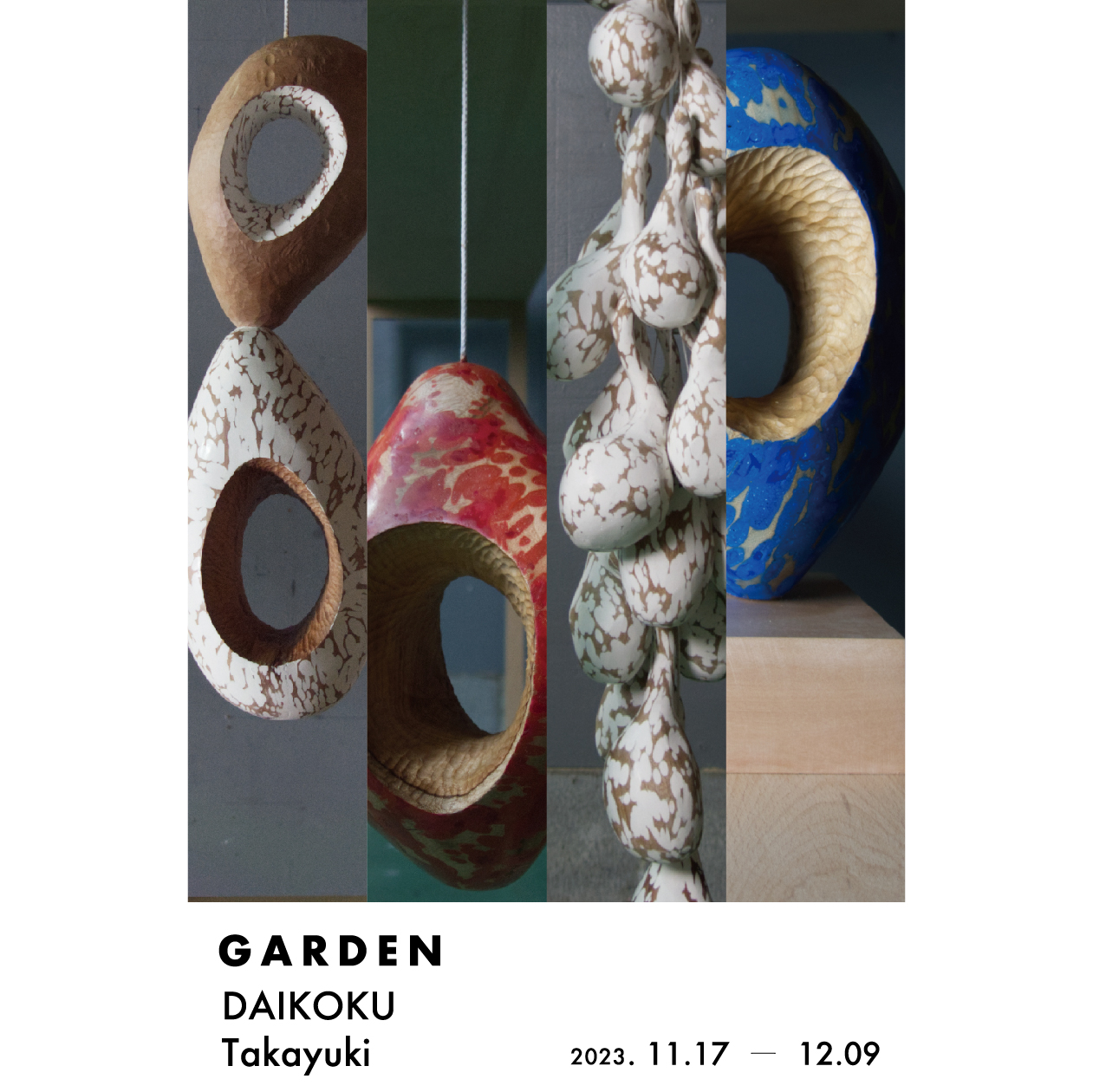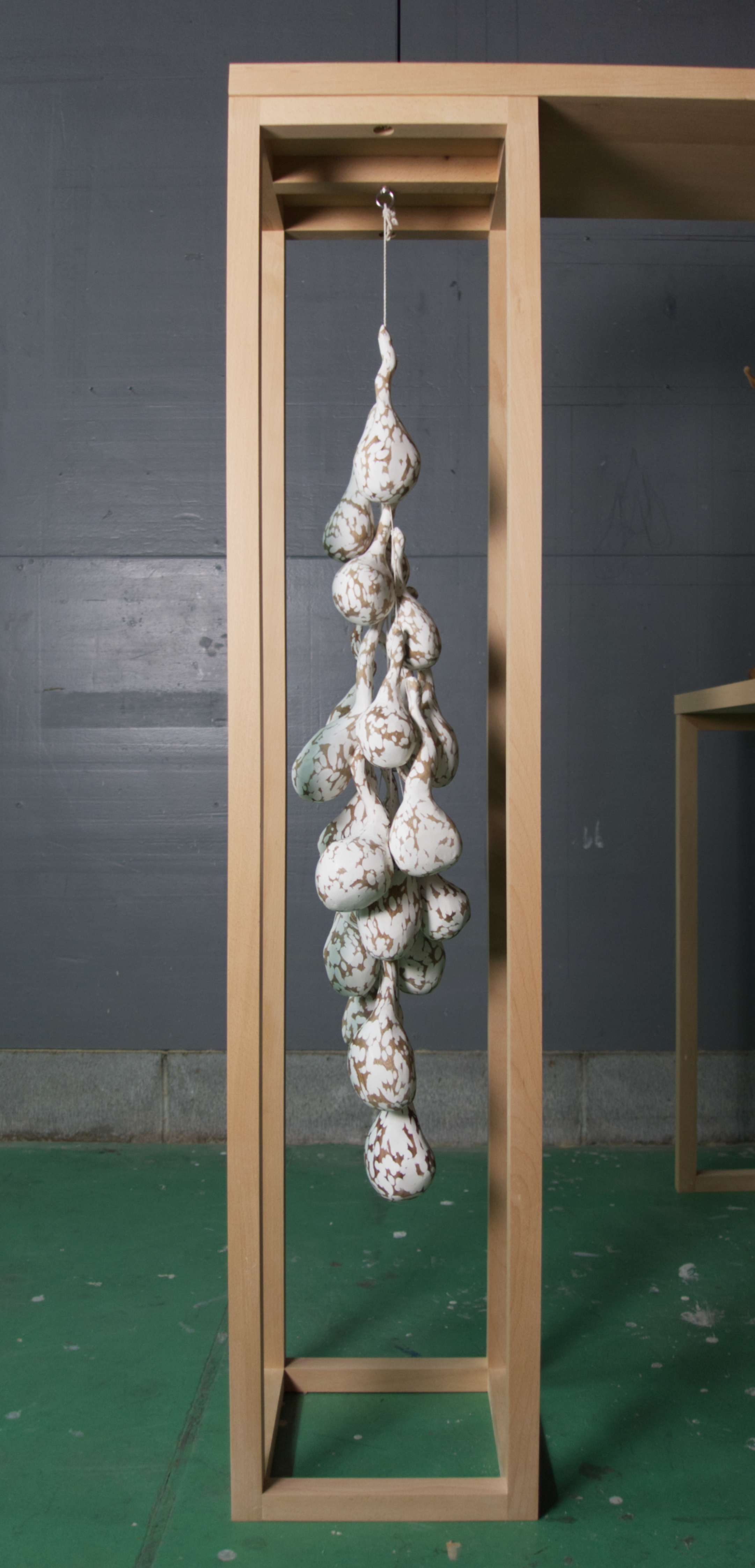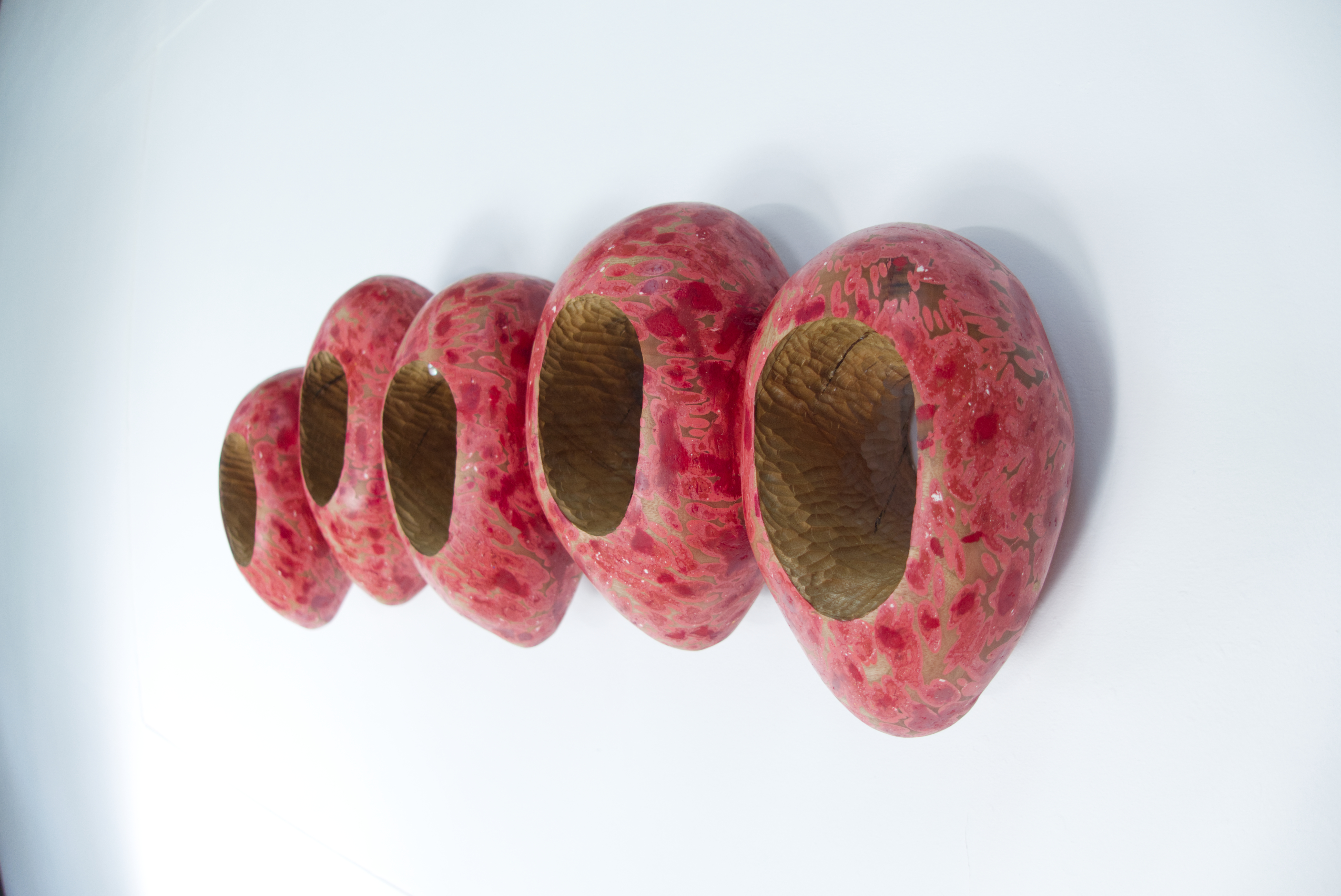
2023.11.17 - 12.09
DAIKOKU Takayuki
MARUEIDO JAPAN is pleased to announce "GARDEN," the first solo exhibition by sculptor DAIKOKU Takayuki in three years.
Born and raised in Omi Hachiman, Shiga Prefecture, a city of rich nature, Daikoku Takayuki (1976-) left for Germany by himself in 2001 after completing his graduate studies, returned to Japan, and then went back to Germany (2011), where he has been showing sculptures, drawings, and installations during his 6.5 years stay. He returned to Japan in 2016 and is currently based in Omi Hachiman, where he was born and lives.
We hope you will take this opportunity to view these works by this talented artist.
【GARDEN】
DAIKOKU Takayuki
The UK’s Mên-an-Tol, which are also known as ''the stones with holes'', consist of two granite pillars and one holed stone that have been placed in a field in Cornwall. Sculptor Sir Antony Mark David Gormley writes in his book Shaping the World: Sculpture from Prehistory to Now that the pillars of this ruin are seen as symbols of men and the holed stone is a symbol for women, and the site can be interpreted as a potential place for rebirth. Pillars have been understood as a fundamental form for life in various cultures since ancient times. This is illustrated by the many examples of pillars that exist, such as the totem poles of the US, the lingas of Cambodia, Japanese pillars, and Constantin Brâncuși’s Endless Column.
The GARDEN exhibition features organic sculptures that are reconstructions of things that can be seen in the natural world, such as flowers, buds, nuts, seeds, eggs, and cells, and these have been placed on pedestals that are reminiscent of shelving, inside wooden frames, or have been hung up on the walls.
I think that in the backdrop to these artworks are memories that are triggered by rice ears in the countryside, shapes of trees and plants in mountains and along rivers, and the landscape of Lake Biwa which I saw as a young child.
My sculptures have simple yet primitive and fundamental forms, such as circles with holes, pillars, or elements that are like drops of water.
Moreover, I have tried an approach of constructing individual sculptures by combining these parts.
There are sculptures in this exhibition that have freshwater pearls cultivated in Nishinoko, which is known as the navel of Lake Biwa.
It takes about six years from the growth of pearls from the larvae of fresh-water mussels until they are ready to be harvested.
It is a natural gem that is created over time between the lake and shellfish, and they are said to be a symbol of Lake Biwa.
Buddhist statues that embody the incarnation of Buddha, enku sculptures, Zen gardens, and strolling gardens, these all visualize the Japanese people's loving gaze and awe of nature that comes from the climate and environment of an island country located in the far east of Asia.
The GARDEN, which invites viewers to interact with art by having them walk around while having lines of sight that go vertically and horizontally, suggests at the concept of a strolling garden.
Referring to a historical fact of when a young Richard Serra saw the garden of a Zen temple in Kyoto he felt that ‘’it is fine if a sculpture is something that you can walk around,'’ it is also possible to perceive entire GARDEN as one single sculpture.
From art that attempts to return to the origin of shapes and structures formed from the flexible cycle of life created by natural diversity and visualize them, a dual structure can be seen to appear, for example ones that are both whole and parts, organic and inorganic, rising and falling, that are spots and lines, and that are two-dimensional and three-dimensional.
An important motif in my art is a conscious of action and materials, and a search for the harmonious beauty that springs forth when disparate things coexist.
____________
References
Shaping the World: Sculpture from Prehistory to Now by Antony Gormley and Martin Gayford, translated by Hisashi Ishizaki and Takuyuki Hayashi, Tokyo Shoseki, 2021
Mori no Okite Gendai Chokoku no Sekai (Forest Rules - The World of Modern Sculpture), Tadayasu Sakai, Ozawa Shoten, 1993
Nihon Shugoron (Japanese Set Theory) Itsuki Uchida, MISHIMASHA PUBLISHING, 2020
Takayuki Daikoku Solo Exhibition "Ununterbrochen", Text written by Philipp Zobel and H. N. Semjon, Semjon Contemporary Berlin 2013
【FOLDED DRAWING】
Folded drawing, an art form that developed from drawing, includes the meanings of folding and drawing. Lines are usually drawn with a pencil, pen, or brush, but the lines in this kind of drawing come from folding. By performing this "action," flat paper becomes slightly raised from the starting point of the folding, and this adds a three-dimensional element. As my folded drawing art has developed, I have also been trying creating holes or using metal materials such as copper and brass plates. These metal artworks are made in the same way as my paper ones, light and shadow appears through the slight irregularities in the surface created by folding and the opened holes. There is no illusion like in a painting, rather these artworks suggest the existence of things that are always there, they are sculptures that have been derived out of the selection of materials and "action."
__________________________________________________________________________________________________________
Capturing Ambiguous Existence
Dr. Shiori Hiraki
PhD History of Art and Archaeology
When I first heard that the title of this exhibition would be GARDEN, I had a surprising impression at first. Gardens are always full of contradictions. In this, I mean that while it is an artificial construct, it is made to look natural using natural materials. For example, strolling gardens which are mentioned in Daikoku's preface were often created during the Edo period in order to imitate famous places in Japan or China. These are gardens that were selected from a human perspective, so they haven’t stayed just as they would be naturally. On the other hand, many of Daikoku's artworks have shapes which are reminiscent of the fundamental forms of nature, so my first thought was if they would be incompatible with a garden. However, once I had read past exhibition catalogs and portfolios, including Daikoku's writings, I came to think anew on whether this title was appropriate.
Natural and artificial. These concepts are often seen as being in conflict with each other. But, do they really contradict each other? And moreover, do we perceive nature objectively, to the point that it can be perceived in as being in conflict? In addition, in regard to famous places, many of Japan's famous places have been selected from within the conventions of waka poetry. Place names are chosen from the perspective that they have the same sounds as other words, and emotions, seasons, scenes, etc. are incorporated into poems in this way. It is said that the nobility of the Heian period who chose famous places actually not likely to leave Kyoto. As such, when they composed a waka poem, they would create ones about famous places while looking at a painting on a Japanese folding screen. Which begs the question, where did this image originate from? Possibly there was something about these places that faciliated the composition of poems. In such a way, famous places have an ambiguous existence, as they are both natural and artificial. Nature has an effect on people, and people reshape nature.
Daikoku says that it is always important to have a dialogue with the wood when making a sculpture. For example, what type of wood to use, what shape is suitable for the wood, at what angle should tools, etc., be inserted, and how to make the best use of the wood grain? Sculptures cannot be created without thinking about the characteristics of the materials. While Daikoku engages in these dialogues, he assimilates the existence of nature and gives it shape. His completed artworks look like elements of nature that have been extracted via the hands of a sculptor, and in this way he makes it easier for us to see nature. This exhibition of lined up artworks communicates to us a strolling garden that has a series of locations modeled after famous places.
Conventionally, Daikoku has been drawn to elements that have a conflicting duality and created artworks that embrace their ambiguity. This also applies to a series of drawings that Daikoku has named Folded Drawings. When I first saw Daikoku's Folded Drawing, I was perplexed as to what exactly his artworks were made of. I was quite surprised to discover that they were made of paper or metal plates, and that they consisted of multiple sheets that had been folded and painted. In the 1960s, painter Lucio Fontana put holes in his canvases to question the ambiguity of paintings that exist between two and three dimensions, but his art would feature a net behind the holes. This makes us be conscious of the spaces before and after the painting, spaces which are separated by the canvas, and this emphasizes the resulting secondary nature of the painting. In contrast, the countless lines and holes created by Daikoku are aiming for three dimensions. The upward fold lines bulge and push forward, and look like they are trying to stay on the surface. On the other hand, with a slight shift of the paper, the holes seem to generate a feeling of peering from above into a living organism's tissue. They look different to other sculptures because of differences in materials, but I think there is probably a consistency in its capturing of elements of nature. Taking it one step further, if a sculpture artwork is a natural positive film, then Folded Drawing seems to be a negative film.
Daikoku says that Folded Drawing has no meaning. Certainly, there isn’t a meaningful motif here. There are only geometrical shapes. Pivoting from this point, a common theme in Japanese art until modern times has been the exploration of the possibilities of materials, especially techniques for changing paper into something that is other to paper, and techniques for creating art that is both a painting and a sculpture. An example of this is a folding screen, folded in a zigzag to stand it upright, that has pictures and calligraphy painted and written on it. Folding screens are primarily used as furniture. Often they have motifs that are embossed and covered with gold or silver leaf, or gold or silver paint to create a three-dimensional appearance. Some folding screens can be appreciated as artistic creations, but in truth many of them are quite fascinating for the metallic gleam of gold and silver, and the meaning of the motif fades into the distance. They are in a variety of dimensions, but they all have one aspect in common. That is, their placement transforms space into something different and adds color to people’s lives. In this exhibition, a collection of Folded Drawings will be exhibited in one room. I am looking forward to seeing what kind of space will make its appearance in that room.
This exhibition, which is organized under the model of a strolling garden, will allow visitors to gaze upon Daikoku's sculptures from various angles. It will be possible to take a closer look at a single artwork, or to experience a perspective that looks out at the exhibition as a whole and in which you can see the rhythm created by its parts and its harmony with the whole. The artworks are on display with calculated differences of height, allowing visitors to almost experience something akin to a trip amid mountains and valleys. And yet, nothing in this experience is the same. The final key to complete a strolling garden is the independent viewer, one who wanders around freely.

